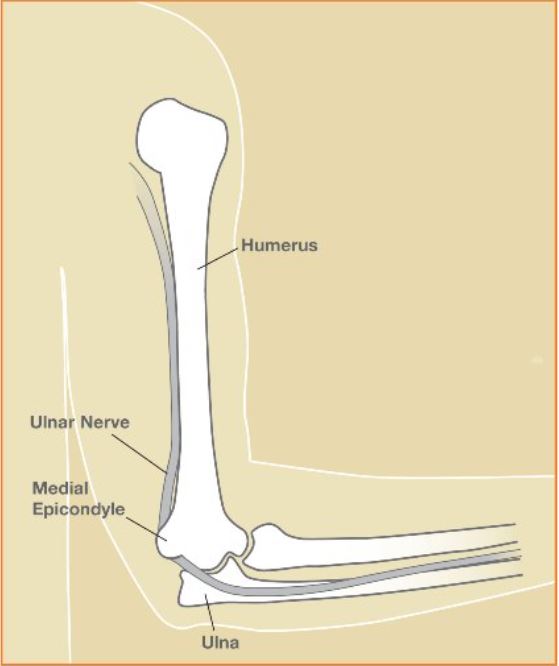What Is the Funny Bone?
The funny bone is neither funny nor a bone. The source of pain when someone “hits their funny bone” is actually related to a nerve on the inside of the elbow. This nerve is called the ulnar nerve. The ulnar nerve is one of the three important nerves that control the hand. It supplies feeling to the pinky and ring finger. It also controls many of the fine motor skill muscles in the hand. When the ulnar nerve is not working properly, the pinky and ring finger go numb and tingly, and the hand can become weak and uncoordinated. Pins and needles, electric pain, and hand numbness are all very common. This is what happens when the ulnar nerve, or “funny bone,” is hit too hard at the elbow.
Cubital tunnel syndrome is a common type of pinched nerve and is related to the ulnar nerve at the elbow. This is the same nerve involved when a person hits their “funny bone.” Patients may experience symptoms such as numbness, tingling, weakness, and pain in the hand and forearm.

As the ulnar nerve travels from the upper arm into the forearm, it courses through the normal groove behind the bony bump on the inside of the elbow (the medial epicondyle). The ulnar nerve is at risk for compression at this site – within the cubital tunnel – as it turns the corner around the elbow. In this area of the elbow, the ulnar nerve is pretty close to the skin and can be bumped easily. The nerve then travels down the forearm and innervates muscles in the forearm and hand to provide sensation to the small finger and ring finger. It is thought that pressure on the nerve reduces neural blood flow, which causes symptoms in the hand.
Patients with cubital tunnel syndrome usually report numbness and tingling in the pinky and ring fingers, or a feeling that these fingers are asleep or swollen. Some people feel “electric” or “shooting” pain down the forearm into the hand, similar to the feeling of “hitting the funny bone.”
Some patients report increased symptoms when the elbow is bent (flexed), such as while talking on a cell phone, driving, or sleeping. Dropping objects, clumsiness with the hands, or a weak grip are also common complaints. In severe or long-standing cases, the small muscles within the hand can become weak and atrophy. This can lead to permanent deformity of the hand, weakness, and hand dysfunction.
Often, the diagnosis can be made on the basis of symptoms, medical history, and physical examination in the office. Hand surgeons are experts in diagnosing nerve conditions in the hand and arm. A nerve conduction study can confirm the diagnosis and assess the severity of the nerve compression.
Not all hand pain or numbness is caused by cubital tunnel syndrome or ulnar nerve problems. Nerves in the arm can be compressed or “pinched” anywhere along their pathway from the neck to the fingers. Therefore, it is important to identify the location of the nerve compression.
Cubital tunnel syndrome is a common type of pinched nerve and is related to the ulnar nerve at the elbow. This is the same nerve involved when a person hits their “funny bone.” Patients may experience symptoms such as numbness, tingling, weakness, and pain in the hand and forearm.
As the ulnar nerve travels from the upper arm into the forearm, it courses through the normal groove behind the bony bump on the inside of the elbow (the medial epicondyle). The ulnar nerve is at risk for compression at this site – within the cubital tunnel – as it turns the corner around the elbow. In this area of the elbow, the ulnar nerve is pretty close to the skin and can be bumped easily. The nerve then travels down the forearm and innervates muscles in the forearm and hand to provide sensation to the small finger and ring finger. It is thought that pressure on the nerve reduces neural blood flow, which causes symptoms in the hand.
Patients with cubital tunnel syndrome usually report numbness and tingling in the pinky and ring fingers, or a feeling that these fingers are asleep or swollen. Some people feel “electric” or “shooting” pain down the forearm into the hand, similar to the feeling of “hitting the funny bone.”
Some patients report increased symptoms when the elbow is bent (flexed), such as while talking on a cell phone, driving, or sleeping. Dropping objects, clumsiness with the hands, or a weak grip are also common complaints. In severe or long-standing cases, the small muscles within the hand can become weak and atrophy. This can lead to permanent deformity of the hand, weakness, and hand dysfunction.
Often, the diagnosis can be made on the basis of symptoms, medical history, and physical examination in the office. Hand surgeons are experts in diagnosing nerve conditions in the hand and arm. A nerve conduction study can confirm the diagnosis and assess the severity of the nerve compression.
Not all hand pain or numbness is caused by cubital tunnel syndrome or ulnar nerve problems. Nerves in the arm can be compressed or “pinched” anywhere along their pathway from the neck to the fingers. Therefore, it is important to identify the location of the nerve compression.
Dr. John M. Erickson is a hand and upper extremity specialist at the Raleigh Hand Center. He trained in orthopedic surgery at the University of Michigan and completed a hand surgery fellowship at Vanderbilt University. He is an active member of the American Society for Surgery of the Hand (ASSH).
Find a hand surgeon near you
Using this search tool means you agree to the user agreement and disclaimer.